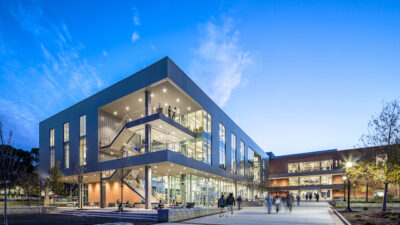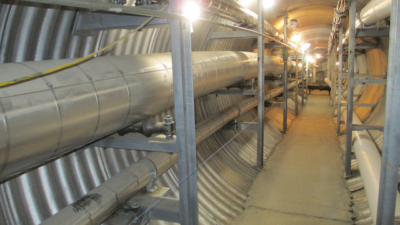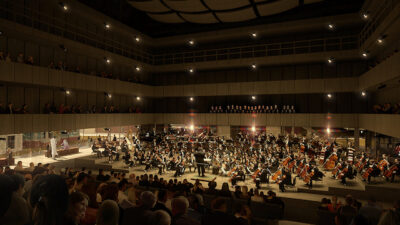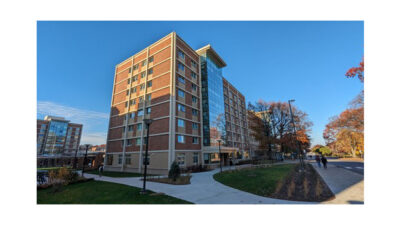Parents and students have high expectations when they select a school, whether it is public or private. They want a quality education that prepares students for the future. State-of-the-art facilities, safety, and security are of primary concern. To meet rising expectations within this cost-sensitive market, schools, colleges, and universities must invest wisely in their facilities as a strategic asset to keep occupants comfortable and to attract faculty and staff.
St. Agnes Academy (SAA) in Houston is an environmentally conscious college preparatory school for young women, educating more than 800 students from all over the Houston area. It came as no surprise to the staff when students expressed a strong desire for the school to reduce its carbon footprint.
Administrators realized that green measures also needed to be financially sound. Most of the school’s current facilities were constructed in 1963. Making them greener meant SAA would have to contend with a variety of issues—from aging building systems and constant-speed motors to inefficient lighting and fixed outside-air intake. Faced with rising energy costs, school officials knew they would have to evaluate and prioritize their conservation efforts, despite annual increases to the budget. For example, in 2006 energy cost $1.50/sq ft; in 2007 the cost rose to $1.76/sq ft; and by 2008 the cost reached $2.01/sq ft.
Intrigued by the opportunity to minimize the impact of rising energy costs on the annual budget, SAA entertained a proposal from TAC by Schneider Electric in February 2008 for a TAC EnergyEdge solution. The comprehensive program was designed to reduce operating costs while improving building environments and system performance. TAC’s proposal for SAA focused on energy conservation measures with rapid payback that aligned with the school’s future facility plans.
Getting to work
Text School officials told TAC that the improvements needed to be completed during the 2008 summer break, so TAC got right to work. TAC met with members of the SAA building and grounds committee to discuss energy conservation efforts that would fit with their budget and 5-year plan, including an established timeline for moving forward. TAC then proceeded with a three-pronged approach: analyzing the school’s utility bills, physically analyzing the facilities, and identifying specific energy conservation measures.
The utility bill analysis included a benchmark comparison of energy costs for schools and other similar facilities in the Houston area and across the country. TAC also reviewed the energy rate structure along with the school’s energy use history, requirements, and demand impact—an often-overlooked opportunity for savings.
TAC also analyzed the 200,000-sq-ft facility to find opportunities to reduce energy consumption. The analysis revealed shortcomings that included aging equipment, outdated lighting, obsolete control strategies, and operational procedures that needed to be fine-tuned.
Over the summer, TAC installed energy-efficient lights, variable-flow water loops, and variable-speed drives. TAC also modified system control sequencing capabilities, making it easy for facilities staff to change setpoints while preventing overheating and overcooling, and controlling demand. Other measures included optimizing chiller operations, air-handling units, and outside-air intake. TAC projects the annual savings from these measures to be $101,667, for a payback of less than 4 years, based on 2008 utility rates.
Motivated by a strong desire to promote environmental responsibility and awareness, SAA embraced a plan designed to take a lead in practicing good stewardship and deliver on its commitment to a green initiative. TAC provided SAA with a roadmap for sustainable growth and the school is now benefiting from improved energy efficiency, a minimized carbon footprint, and reduced energy spending that is delivering a rapid payback. This results in a reduction in operating costs and enables the reallocation of saved resources to new programs for students within the same budget.
SAA will now have an annual positive environmental impact that equates to reducing energy consumption by 624,981 kWh and to releasing 484 fewer tons of carbon dioxide into the atmosphere. This is equivalent to removing 104 cars from the roads, powering 59 residential homes, or planting 677 trees to help restore the ecosystem balance.
In addition to project installation, SAA and TAC have joined forces to become partners in education. TAC has agreed to host a Green Forum for other Houston-area Catholic schools, commit internal resources to SAA in celebration of Earth Day, and involve the students in continuous tracking of the school’s energy conservation efforts.
The project has enabled SAA to leverage the school’s existing infrastructure to reduce its annual energy usage. Moreover, this project has put the school in a unique position in the community as a leader in sustainability and social responsibility. SAA has certainly answered the student challenge to become greener.
Information provided by TAC
One year later
Nearly a full year after the renovations at Houston’s St. Agnes Academy (SAA), the school is already reaping the benefits. With 2 months left in the first year of measured savings, SAA has cut consumption by 6,12K kWh and 1,835 Mcf, which has equated to $80,000 in savings thus far. The numbers show the school is at 98% of its goal, which means it is on pace to exceed savings in all categories.
TAC continues to work with the SAA staff to ensure they are operating their systems in a way that maximizes savings. There is always room for improvement in this category, which means that savings will continue to increase as TAC and the school work together to fine-tune processes.
AT A GLANCE
TAC by Schneider Electric worked with St. Agnes Academy (SAA) in Houston to make the private girls’ school more energy-efficient and better for the environment. By installing energy-efficient lights, variable flow water loops, and variable speed drives, TAC decreased the amount of power the school uses.
SAA also received a modification system that allows faculty members and staff to change setpoints while preventing overheating and overcooling, and controlling demand. Other measures included optimizing chiller operations, air-handling units, and outside-air intake. The changes to the 200,000-sq-ft school led to savings of more than $100,000.



